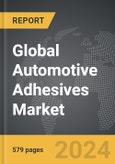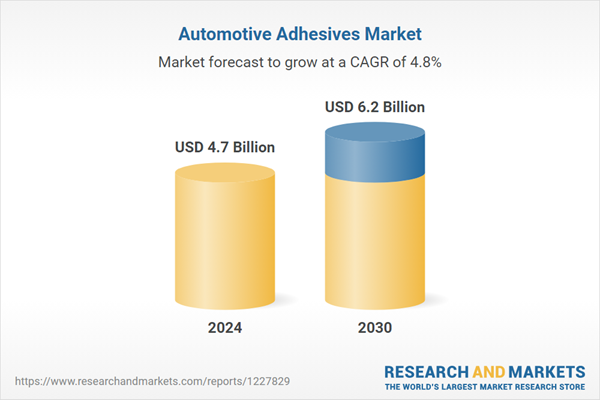The global market for Automotive Adhesives was valued at US$4.7 Billion in 2024 and is projected to reach US$6.2 Billion by 2030, growing at a CAGR of 4.8% from 2024 to 2030. This comprehensive report provides an in-depth analysis of market trends, drivers, and forecasts, helping you make informed business decisions. The report includes the most recent global tariff developments and how they impact the Automotive Adhesives market.
The development and application of automotive adhesives have been significantly influenced by advancements in material science and manufacturing processes. Innovations such as hybrid adhesives combine the best properties of different adhesive types, providing superior performance in challenging conditions. Additionally, the use of advanced application techniques, such as robotic dispensing systems, ensures precise and efficient adhesive placement, improving production speed and consistency. The shift towards lightweight materials in automotive manufacturing, including the increased use of aluminum and composites, has further driven the demand for specialized adhesives capable of bonding dissimilar materials effectively. This trend is particularly relevant in the production of electric vehicles (EVs), where weight reduction is critical to maximizing battery efficiency and range. Furthermore, automotive adhesives contribute to noise, vibration, and harshness (NVH) reduction, enhancing overall vehicle comfort and driving experience.
The growth in the automotive adhesives market is driven by several factors, including technological advancements, the increasing production of electric vehicles, and stringent environmental regulations. Technological advancements have led to the development of high-performance adhesives that offer better bonding strength, durability, and resistance to extreme temperatures and chemicals. These improvements have expanded the applications of adhesives in the automotive sector, enabling manufacturers to design vehicles with greater flexibility and innovation. The surge in electric vehicle production has also significantly boosted the demand for automotive adhesives, as these vehicles require lightweight and durable bonding solutions to optimize performance and battery life. Additionally, stringent environmental regulations aimed at reducing vehicle emissions and improving fuel efficiency have encouraged the use of adhesives over traditional welding and mechanical fastening methods, as adhesives contribute to overall weight reduction. The growing consumer demand for safer, quieter, and more fuel-efficient vehicles further supports the adoption of advanced adhesive technologies. These factors collectively highlight the dynamic growth of the automotive adhesives market, emphasizing its critical role in the evolution of vehicle design and manufacturing.
Segments: Function (Bonding, NVH, Sealing/Protection); Vehicle Type (Passenger Cars, LCV, HCV & MCV); Application (Body in White (BIW), Assembly, Powertrain, Paint Shop).
Geographic Regions/Countries: World; USA; Canada; Japan; China; Europe; France; Germany; Italy; UK; Spain; Russia; Rest of Europe; Asia-Pacific; Australia; India; South Korea; Rest of Asia-Pacific; Latin America; Argentina; Brazil; Mexico; Rest of Latin America; Middle East; Iran; Israel; Saudi Arabia; UAE; Rest of Middle East; Africa.
The analysts continuously track trade developments worldwide, drawing insights from leading global economists and over 200 industry and policy institutions, including think tanks, trade organizations, and national economic advisory bodies. This intelligence is integrated into forecasting models to provide timely, data-driven analysis of emerging risks and opportunities.
Global Automotive Adhesives Market - Key Trends & Drivers Summarized
Automotive adhesives play a crucial role in the modern automotive industry, providing essential bonding solutions that enhance the performance, safety, and aesthetics of vehicles. These adhesives are used in various applications, including body panels, interior trim, glass bonding, and structural components. They offer several advantages over traditional mechanical fasteners, such as reducing the vehicle's weight, improving fuel efficiency, and enhancing crashworthiness by distributing stress more evenly. Types of automotive adhesives include epoxy, polyurethane, silicone, acrylic, and cyanoacrylate, each with specific properties tailored to different uses within a vehicle. For instance, epoxy adhesives are known for their high strength and durability, making them suitable for structural applications, while polyurethane adhesives provide flexibility and resistance to environmental factors, ideal for bonding different materials like glass and metal.The development and application of automotive adhesives have been significantly influenced by advancements in material science and manufacturing processes. Innovations such as hybrid adhesives combine the best properties of different adhesive types, providing superior performance in challenging conditions. Additionally, the use of advanced application techniques, such as robotic dispensing systems, ensures precise and efficient adhesive placement, improving production speed and consistency. The shift towards lightweight materials in automotive manufacturing, including the increased use of aluminum and composites, has further driven the demand for specialized adhesives capable of bonding dissimilar materials effectively. This trend is particularly relevant in the production of electric vehicles (EVs), where weight reduction is critical to maximizing battery efficiency and range. Furthermore, automotive adhesives contribute to noise, vibration, and harshness (NVH) reduction, enhancing overall vehicle comfort and driving experience.
The growth in the automotive adhesives market is driven by several factors, including technological advancements, the increasing production of electric vehicles, and stringent environmental regulations. Technological advancements have led to the development of high-performance adhesives that offer better bonding strength, durability, and resistance to extreme temperatures and chemicals. These improvements have expanded the applications of adhesives in the automotive sector, enabling manufacturers to design vehicles with greater flexibility and innovation. The surge in electric vehicle production has also significantly boosted the demand for automotive adhesives, as these vehicles require lightweight and durable bonding solutions to optimize performance and battery life. Additionally, stringent environmental regulations aimed at reducing vehicle emissions and improving fuel efficiency have encouraged the use of adhesives over traditional welding and mechanical fastening methods, as adhesives contribute to overall weight reduction. The growing consumer demand for safer, quieter, and more fuel-efficient vehicles further supports the adoption of advanced adhesive technologies. These factors collectively highlight the dynamic growth of the automotive adhesives market, emphasizing its critical role in the evolution of vehicle design and manufacturing.
Report Scope
The report analyzes the Automotive Adhesives market, presented in terms of units. The analysis covers the key segments and geographic regions outlined below.Segments: Function (Bonding, NVH, Sealing/Protection); Vehicle Type (Passenger Cars, LCV, HCV & MCV); Application (Body in White (BIW), Assembly, Powertrain, Paint Shop).
Geographic Regions/Countries: World; USA; Canada; Japan; China; Europe; France; Germany; Italy; UK; Spain; Russia; Rest of Europe; Asia-Pacific; Australia; India; South Korea; Rest of Asia-Pacific; Latin America; Argentina; Brazil; Mexico; Rest of Latin America; Middle East; Iran; Israel; Saudi Arabia; UAE; Rest of Middle East; Africa.
Key Insights:
- Market Growth: Understand the significant growth trajectory of the Passenger Cars segment, which is expected to reach US$4.0 Billion by 2030 with a CAGR of a 4.4%. The LCV segment is also set to grow at 5.6% CAGR over the analysis period.
- Regional Analysis: Gain insights into the U.S. market, valued at $651.0 Million in 2024, and China, forecasted to grow at an impressive 6.2% CAGR to reach $1.9 Billion by 2030. Discover growth trends in other key regions, including Japan, Canada, Germany, and the Asia-Pacific.
Why You Should Buy This Report:
- Detailed Market Analysis: Access a thorough analysis of the Global Automotive Adhesives Market, covering all major geographic regions and market segments.
- Competitive Insights: Get an overview of the competitive landscape, including the market presence of major players across different geographies.
- Future Trends and Drivers: Understand the key trends and drivers shaping the future of the Global Automotive Adhesives Market.
- Actionable Insights: Benefit from actionable insights that can help you identify new revenue opportunities and make strategic business decisions.
Key Questions Answered:
- How is the Global Automotive Adhesives Market expected to evolve by 2030?
- What are the main drivers and restraints affecting the market?
- Which market segments will grow the most over the forecast period?
- How will market shares for different regions and segments change by 2030?
- Who are the leading players in the market, and what are their prospects?
Report Features:
- Comprehensive Market Data: Independent analysis of annual sales and market forecasts in US$ Million from 2024 to 2030.
- In-Depth Regional Analysis: Detailed insights into key markets, including the U.S., China, Japan, Canada, Europe, Asia-Pacific, Latin America, Middle East, and Africa.
- Company Profiles: Coverage of players such as BASF SE, 3M Company, Arkema Group, Ashland Global Holdings, Inc., Bostik, Inc. and more.
- Complimentary Updates: Receive free report updates for one year to keep you informed of the latest market developments.
Some of the 102 companies featured in this Automotive Adhesives market report include:
- BASF SE
- 3M Company
- Arkema Group
- Ashland Global Holdings, Inc.
- Bostik, Inc.
- Adhesives Research, Inc.
- AI Technology, Inc.
- Adchem Corporation
- Beardow & Adams (Adhesives) Ltd.
- Adhesive Technologies, Inc.
- Bondloc UK Ltd.
- ABRO Industries, Inc.
- Capital Adhesives & Packaging Corporation
- Alberdingk Boley GmbH
- Anabond Limited
Tariff Impact Analysis: Key Insights for 2025
Global tariff negotiations across 180+ countries are reshaping supply chains, costs, and competitiveness. This report reflects the latest developments as of April 2025 and incorporates forward-looking insights into the market outlook.The analysts continuously track trade developments worldwide, drawing insights from leading global economists and over 200 industry and policy institutions, including think tanks, trade organizations, and national economic advisory bodies. This intelligence is integrated into forecasting models to provide timely, data-driven analysis of emerging risks and opportunities.
What’s Included in This Edition:
- Tariff-adjusted market forecasts by region and segment
- Analysis of cost and supply chain implications by sourcing and trade exposure
- Strategic insights into geographic shifts
Buyers receive a free July 2025 update with:
- Finalized tariff impacts and new trade agreement effects
- Updated projections reflecting global sourcing and cost shifts
- Expanded country-specific coverage across the industry
Table of Contents
I. METHODOLOGYII. EXECUTIVE SUMMARY2. FOCUS ON SELECT PLAYERSIII. MARKET ANALYSISCANADAITALYSPAINRUSSIAREST OF EUROPESOUTH KOREAREST OF ASIA-PACIFICARGENTINABRAZILMEXICOREST OF LATIN AMERICAIV. COMPETITION
1. MARKET OVERVIEW
3. MARKET TRENDS & DRIVERS
4. GLOBAL MARKET PERSPECTIVE
UNITED STATES
JAPAN
CHINA
EUROPE
FRANCE
GERMANY
UNITED KINGDOM
ASIA-PACIFIC
AUSTRALIA
INDIA
LATIN AMERICA
MIDDLE EAST
AFRICA
Companies Mentioned (Partial List)
A selection of companies mentioned in this report includes, but is not limited to:
- BASF SE
- 3M Company
- Arkema Group
- Ashland Global Holdings, Inc.
- Bostik, Inc.
- Adhesives Research, Inc.
- AI Technology, Inc.
- Adchem Corporation
- Beardow & Adams (Adhesives) Ltd.
- Adhesive Technologies, Inc.
- Bondloc UK Ltd.
- ABRO Industries, Inc.
- Capital Adhesives & Packaging Corporation
- Alberdingk Boley GmbH
- Anabond Limited
Table Information
| Report Attribute | Details |
|---|---|
| No. of Pages | 579 |
| Published | April 2025 |
| Forecast Period | 2024 - 2030 |
| Estimated Market Value ( USD | $ 4.7 Billion |
| Forecasted Market Value ( USD | $ 6.2 Billion |
| Compound Annual Growth Rate | 4.8% |
| Regions Covered | Global |









